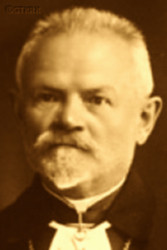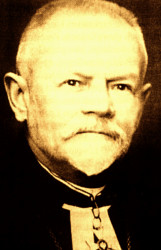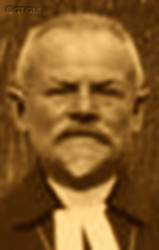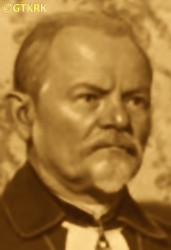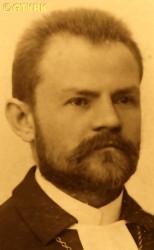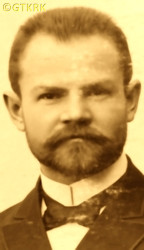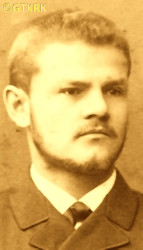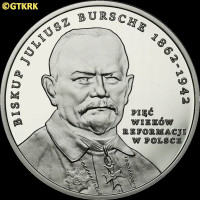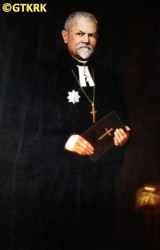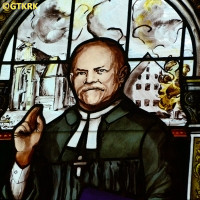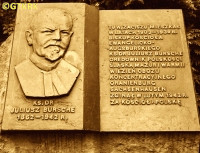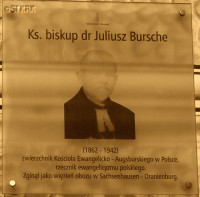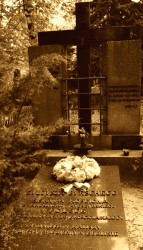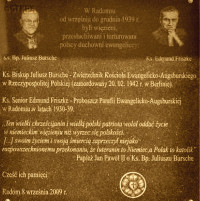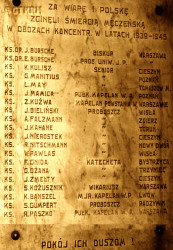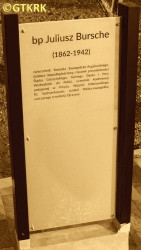Roman Catholic
St Sigismund parish
05-507 Słomczyn
85 Wiślana Str.
Konstancin deanery
Warsaw archdiocese, Poland
full list:
displayClick to display full list

searchClick to search full list by categories
wyświetlKliknij by wyświetlić pełną listę po polsku

szukajKliknij by przeszukać listę wg kategorii po polsku

Martyrology of the clergy — Poland
XX century (1914 – 1989)
personal data
surname
BURSCHE
forename(s)
Julius (pl. Juliusz)
function
bishop (general superintendent)
creed
Evangelical Church of the Augsburg Confession in Poland EA
academic distinctions
Doctor of Theology
honorary titles
„White Eagle” Ordermore on
en.wikipedia.org
[access: 2019.04.16]
(06.11.2018)
„Polonia Restituta” Cross — 2nd Class, Commander's with Starmore on
en.wikipedia.org
[access: 2019.04.16]
(02.05.1922)
Doctor Honoris Causa
(1930, Warsawtoday: Warsaw city pov., Masovia voiv., Poland
more on
en.wikipedia.org
[access: 2021.10.09]; University of Warsaw UW, Evangelical Theology Department)
nationality
German
date and place
of death
20.02.1942

Berlintoday: Berlin state, Germany
more on
en.wikipedia.org
[access: 2020.07.31]
alt. dates and places
of death
1942
KL Sachsenhausenconcentration camp
today: Sachsenhausen‐Oranienburg, Oberhavel dist., Brandenburg state, Germany
more on
en.wikipedia.org
[access: 2018.11.18]
details of death
At the outbreak of World War I, rested in Wisła, then in the Austro–Hungarian Empire.
Threatened with internment — as a subject of the Russian Empire — via Vienna, Budapest, Bucharest, Iași and Odessa, returned to Warsaw.
From there, in 04.1915, just before the Russian defeat in the Battle of Gorlice in 05.1915, exiled — as an Evangelical, i.e. automatically suspected of pro–German sympathies — to Orenburg in Russia (after the defeat at Gorlice, a panicky flight of Russians from the Russian partition, called bezhenstvo, began).
Changed his place of residence several times — lived e.g. in Moscow and Tver.
On 17.02.1918 — therefore before Russia, Germany and Austria signed the separatist peace treaty in Brześć in 03.1918 — returned to Poland via Stockholm.
Before the end of World War I and before Poland regained independence on 11.11.1918, joined the State Council of the Kingdom of Poland, an entity established by the German and Austrian occupiers.
On 05.02.1919 to 11.03.1919 Polish expert on Cieszyn Silesia and former East Prussia region during Versailles n. Paris peace negotiations — submitted a memorial „Voice of Polish Evangelical pastors on the incorporation of Cieszyn Silesia and Upper Silesia into Poland”.
In 1919‐1920 manager of Polish plebiscite committee during preparation for a plebiscite that was to decide the state fate of Masurian and Warmia region.
In 09.1936 issued a proclamation to the Evangelical believers in Poland condemning German national socialism.
After German invasion of Poland in 01.09.1939 (Russians invaded Poland 17 days later) and start of the World War II, issued on 01.09.1939 a letter that was to read from the pulpit in all Evangelical churches condemning German invasion.
With thousands of refugees evacuated himself east.
Reached Lublin when German occupation started.
There on 02‐03.10.1939 in Evangelical parish arrested by the Germans in Lublin.
Transported to Radom and there interrogated in prison.
Next in 12.1939 transported to Gestapo main offices and prison in Berlin.
Jailed in KL Sachsenhausen concentration camp.
Tortured repeatedly.
Perished in police hospital, after another interrogation in Moabit prison in Berlin.
prisoner camp's numbers
166, 14966Click to display source page (KL SachsenhausenClick to display the description)
cause of death
murder
perpetrators
Germans
sites and events
Berlin (Moabit)Click to display the description, KL SachsenhausenClick to display the description, RadomClick to display the description, «Intelligenzaktion»Click to display the description, Ribbentrop‐MolotovClick to display the description, Forced exileClick to display the description
date and place
of birth
19.09.1862

Kalisztoday: Kalisz city pov., Greater Poland voiv., Poland
more on
en.wikipedia.org
[access: 2020.12.16]
parents
BURSCHE Ernest William
🞲 09.08.1831, Turektoday: Turek gm., Turek pov., Greater Poland voiv., Poland
more on
en.wikipedia.org
[access: 2020.12.11] — 🕆 06.04.1904, Zgierztoday: Zgierz urban gm., Zgierz pov., Łódź voiv., Poland
more on
en.wikipedia.org
[access: 2021.12.18]

MÜLLER Matilde
🞲 ?, ? — 🕆 1875, ?
presbyter (holy orders)
ordination
30.11.1884

Warsawtoday: Warsaw city pov., Masovia voiv., Poland
more on
en.wikipedia.org
[access: 2021.10.09]
positions held
1920 – 1939
general superintendent — Warsawtoday: Warsaw city pov., Masovia voiv., Poland
more on
en.wikipedia.org
[access: 2021.10.09] ⋄ Evangelical Church of the Augsburg Confession in Poland — from 03.07.1937, according to the new statute of the Church, the first bishop
1930
Doctor Honoris Causa — Warsawtoday: Warsaw city pov., Masovia voiv., Poland
more on
en.wikipedia.org
[access: 2021.10.09] ⋄ Evangelical Theology Department, University of Warsaw [i.e. University of Warsaw (from 1945) / clandestine University (1939‐1945) / Joseph Piłsudski University (1935‐1939) / University of Warsaw (1915‐1935) / Imperial University of Warsaw (1870‐1915)]
1926 – 1935
president — Council of Evangelical Churches in Poland
1904 – 1920
superintendent–senior — Warsawtoday: Warsaw city pov., Masovia voiv., Poland
more on
en.wikipedia.org
[access: 2021.10.09] ⋄ Warsaw EA seniority (commissariat) — covering the territory of the Kingdom of Poland, part of the Russian Empire (till 1915), and then the Kingdom of Poland created by the German occupier (1915‐1918); election on 01.12.1904, installation on 22.01.1905 in the Holy Trinity church in Warsaw
1898 – 1920
parish priest — Warsawtoday: Warsaw city pov., Masovia voiv., Poland
more on
en.wikipedia.org
[access: 2021.10.09] ⋄ Holy Trinity EA parish — i.e. first parish priest; also: spiritual counselor of the Consistory (till 1904)
1895 – 1898
deputy parish priest — Warsawtoday: Warsaw city pov., Masovia voiv., Poland
more on
en.wikipedia.org
[access: 2021.10.09] ⋄ Holy Trinity EA parish — i.e. second parish priest; also: spiritual counselor of the Consistory
1888 – 1895
minister — Warsawtoday: Warsaw city pov., Masovia voiv., Poland
more on
en.wikipedia.org
[access: 2021.10.09] ⋄ Holy Trinity EA parish
1885 – 1888
minister — Wiskitkitoday: Wiskitki gm., Żyrardów pov., Masovia voiv., Poland
more on
en.wikipedia.org
[access: 2022.04.12] ⋄ EA parish
1884 – 1885
vicar — Warsawtoday: Warsaw city pov., Masovia voiv., Poland
more on
en.wikipedia.org
[access: 2021.10.09] ⋄ Holy Trinity EA parish
till c. 1884
student — Dorpattoday: Tartu, Tartu city mun., Tartu cou., Estonia
more on
en.wikipedia.org
[access: 2023.03.24] ⋄ Evangelical Theology Department, University of Dorpat — also: member of „Polonia Convent” academic corporation
founder, publicist and publisher of the magazines, incl. „Gospel Herald” (from 1898), „Masurian Newspaper”
from 1885
married — five children
others related
in death
BANSZELClick to display biography Charles, BIELIŃSKIClick to display biography Joseph, BURSCHEClick to display biography Edmund, FALZMANNClick to display biography Alexander Charles, FREYDEClick to display biography Alfred, GNIDAClick to display biography Francis, GUMPERTClick to display biography Steven Edward, GUTKNECHTClick to display biography Bruno, GUTSCHClick to display biography Sigismund, HAUSEClick to display biography Paul Henry, KAHANEClick to display biography George, KOŻUSZNIKClick to display biography Stanislav, KULISZClick to display biography Charles, KUŹWAClick to display biography Sigismund, LEHMANNClick to display biography George, MAYClick to display biography Leo Witold, MAMICAClick to display biography Joseph, MANITIUSClick to display biography Gustav, NIEROSTEKClick to display biography Joseph, NITSCHMANNClick to display biography Adam Robert, OŻANAClick to display biography Gustav, PASZKOClick to display biography Richard, PAWLASClick to display biography Vladislav, WAGNERClick to display biography Richard Ernest, ZMEŁTYClick to display biography Adolph
sites and events
descriptions
Berlin (Moabit): Prison in Berlin at Lehrter Straße, called Germ. Zellengefängnis (Eng. Cell prison), constructed in 1842‐1849 by the order of Frederic William IV, King of Prussia. During World War II German army Wehrmacht remand prison, and next German political police Gestapo prison. Place of execution including by beheading. Place of death of many Poles. Shut down in 1957‐1958. (more on: en.wikipedia.orgClick to attempt to display webpage
[access: 2019.11.17])
KL Sachsenhausen: In Germ. Konzentrationslager (Eng. concentration camp) KL Sachsenhausen, set up in the former Olympic village in 07.1936, hundreds of Polish priests were held in 1940, before being transported to KL Dachau. Some of them perished in KL Sachsenhausen. Murderous medical experiments on prisoners were carried out in the camp. In 1942‐1944 c. 140 prisoners slaved at manufacturing false British pounds, passports, visas, stamps and other documents. Other prisoners also had to do slave work, for Heinkel aircraft manufacturer, AEG and Siemens among others. On average c. 50,000 prisoners were held at any time. Altogether more than 200,000 inmates were in jailed in KL Sachsenhausen and its branched, out of which tens of thousands perished. Prior to Russian arrival mass evacuation was ordered by the Germans and c. 80,000 prisoners were marched west in so‐called „death marches” to other camps, i.e. KL Mauthausen‐Gusen and KL Bergen‐Belsen. The camp got liberated on 22.04.1945. After end of armed hostilities Germans set up there secret camp for German prisoners and „suspicious” Russian soldiers. (more on: en.wikipedia.orgClick to attempt to display webpage
[access: 2018.11.18])
Radom: The prison in Radom was established in 1817 by the Russian authorities (during partitions of Poland) and operated in the building of the former convent of the Benedictine Sisters. After the start of the German occupation in 09‐10.1939, Germans categorized the prison as a so‐called independent judicial prison, generally supervised by the Justice Department of the Government of the Germ. Generalgouvernement (Eng. General Governorate), and within the district — by the Justice Department of the Governor's Office of the District of Radom. It was called interchangeably Germ. „Gefängnis Radom” (Eng. „Prison in Radom”) and Germ. „Deutsche Strafanstalt Radom” (Eng. „German prison in Radom”). The prison had three departments: women's, criminal, German, and from the end of 1942, the Germ. „Sonderabteilung” (Eng. „Special department”) managed by the German political police Gestapo. During the World War II, c. 18,000 people — mostly political prisoners — passed through it (14,170 files of inmates have survived). At least several thousand were murdered or taken to concentration camps. The prison operated under German supervision until c. 15.01.1945 (the last transport sent to KL Auschwitz left on 14.01.1945 — it only reached Częstochowa, and the rest of the prisoners were murdered by the Germans). After the end of the military operations of World War II and the beginning of the Russian occupation in 1945, members of Polish independence organizations were held there. On 09.09.1945 armed underground units (Freedom and Independence WiN and National Military Organization NOW, consisting of former members of the Home Army AK, „Jodła” region — part of the former Polish Clandestine State) commanded by Stefan Bembiński „Harnas”, freed 292 inmates, including 60 former Home Army AK soldiers arrested by a unit of the Commie‐Nazi Security Office of the UB (subordinate to the Russian NKVD). (more on: www.polskaniezwykla.plClick to attempt to display webpage
[access: 2013.08.17])
«Intelligenzaktion»: German: «Intelligenzaktion» (English: „Intelligence Action”) — a German program of extermination of the Polish elite, mainly the intelligentsia and leadership layers, carried out from the beginning of the occupation in w 09.1939 to 04.1940, mainly in territories directly annexed to Germany, but also in the so‐called Germ. Generalgouvernement (Eng. General Governorate), where it was called «AB‐aktion». In the first phase, immediately after the beginning of the German occupation, during military operations carried out by the Germ. Wehrmacht (Eng. Armed Forces) and the genocidal units of the Germ. Einsatzgruppen (Eng. Operational Groups) of the Germ. Sicherheitspolizei (Eng. Security Police), i.e. SiPo, and Germ. Sicherheitsdienst des Reichsführers SS (Eng. Security Service of the Reichsführer SS), i.e. SD, organized by the Germ. Reichssicherheitshauptamt (Eng. Reich Main Security Office), i.e. RSHA, which followed the troops, carried out under the Germ. Unternehmen „Tannenberg” (Eng. Operation „Tannenberg”) — based on the so‐called Germ. Sonderfahndungsliste (Eng. Special Wanted Lists), i.e. proscription lists of Poles considered particularly dangerous to the Third Reich, prepared by the Zentralstelle II/P (Polen) unit of the German RSHA. Later, implemented by the German civilian occupation authorities and the genocidal unit of the Germ. Volksdeutscher Selbstschutz (Eng. Ethnic Germans Self‐Defense), whose members were Germ. Volksdeutsche (Eng. Ethnic Germans), i.e. representatives of the German minority in Poland. According to various sources, these lists, at the beginning of 09.1939, could have contained the details of 61,000—88,000 „dangerous” Poles — although these figures cannot be confirmed. In total, during this genocide, c. 50,000 teachers, Catholic priests, representatives of the landed gentry, freelancers, social and political activists, and retired military personnel were systematically and methodically murdered. Another 50,000 were sent to concentration camps, where only a negligible percentage survived. (more on: en.wikipedia.orgClick to attempt to display webpage
[access: 2014.10.04])
Ribbentrop‐Molotov: Genocidal Russian‐German alliance pact between Russian leader Joseph Stalin and German leader Adolf Hitler signed on 23.08.1939 in Moscow by respective foreign ministers, Mr. Vyacheslav Molotov for Russia and Joachim von Ribbentrop for Germany. The pact sanctioned and was the direct cause of joint Russian and German invasion of Poland and the outbreak of the World War II in 09.1939. In a political sense, the pact was an attempt to restore the status quo ante before 1914, with one exception, namely the „commercial” exchange of the so‐called „Kingdom of Poland”, which in 1914 was part of the Russian Empire, fore Eastern Galicia (today's western Ukraine), in 1914 belonging to the Austro‐Hungarian Empire. Galicia, including Lviv, was to be taken over by the Russians, the „Kingdom of Poland” — under the name of the General Governorate — Germany. The resultant „war was one of the greatest calamities and dramas of humanity in history, for two atheistic and anti‐Christian ideologies — national and international socialism — rejected God and His fifth Decalogue commandment: Thou shall not kill!” (Abp Stanislav Gądecki, 01.09.2019). The decisions taken — backed up by the betrayal of the formal allies of Poland, France and Germany, which on 12.09.1939, at a joint conference in Abbeville, decided not to provide aid to attacked Poland and not to take military action against Germany (a clear breach of treaty obligations with Poland) — were on 28.09.1939 slightly altered and made more precise when a treaty on „German‐Russian boundaries and friendship” was agreed by the same murderous signatories. One of its findings was establishment of spheres of influence in Central and Eastern Europe and in consequence IV partition of Poland. In one of its secret annexes agreed, that: „the Signatories will not tolerate on its respective territories any Polish propaganda that affects the territory of the other Side. On their respective territories they will suppress all such propaganda and inform each other of the measures taken to accomplish it”. The agreements resulted in a series of meeting between two genocidal organization representing both sides — German Gestapo and Russian NKVD when coordination of efforts to exterminate Polish intelligentsia and Polish leading classes (in Germany called «Intelligenzaktion», in Russia took the form of Katyń massacres) where discussed. Resulted in deaths of hundreds of thousands of Polish intelligentsia, including thousands of priests presented here, and tens of millions of ordinary people,. The results of this Russian‐German pact lasted till 1989 and are still in evidence even today. (more on: en.wikipedia.orgClick to attempt to display webpage
[access: 2015.09.30])
Forced exile: One of the standard Russian forms of repression. The prisoners were usually taken to a small village in the middle of nowhere — somewhere in Siberia, in far north or far east — dropped out of the train carriage or a cart, left out without means of subsistence or place to live. (more on: en.wikipedia.orgClick to attempt to display webpage
[access: 2014.12.20])
sources
personal:
old.luteranie.plClick to attempt to display webpage
[access: 2012.11.23], www.niedziela.diecezja.torun.plClick to attempt to display webpage
[access: 2012.11.23], pl.wikipedia.orgClick to attempt to display webpage
[access: 2013.08.10]
original images:
www.polacyzwyboru.plClick to attempt to display webpage
[access: 2015.09.30], pl.wikipedia.orgClick to attempt to display webpage
[access: 2015.09.30], www.audiovis.nac.gov.plClick to attempt to display webpage
[access: 2015.09.30], sluzyliniepodleglej.plClick to attempt to display webpage
[access: 2019.04.16], polona.plClick to attempt to display webpage
[access: 2019.04.16], edukacja.ipn.gov.plClick to attempt to display webpage
[access: 2024.03.15], edukacja.ipn.gov.plClick to attempt to display webpage
[access: 2024.03.15], archiwum.niemczyk.plClick to attempt to display webpage
[access: 2019.04.16], www.trojca.waw.plClick to attempt to display webpage
[access: 2019.04.16], pl.wikipedia.orgClick to attempt to display webpage
[access: 2019.04.16], wisla.luteranie.plClick to attempt to display webpage
[access: 2019.04.16], pl.wikipedia.orgClick to attempt to display webpage
[access: 2015.09.30], pl.wikipedia.orgClick to attempt to display webpage
[access: 2015.09.30], radom.cityClick to attempt to display webpage
[access: 2015.09.30], www.miejscapamiecinarodowej.plClick to attempt to display webpage
[access: 2013.12.04], infobeskidy.euClick to attempt to display webpage
[access: 2020.05.25]
LETTER to CUSTODIAN/ADMINISTRATOR
If you have an Email client on your communicator/computer — such as Mozilla Thunderbird, Windows Mail or Microsoft Outlook, described at WikipediaPatrz:
en.wikipedia.org, among others — try the link below, please:
LETTER to CUSTODIAN/ADMINISTRATORClick and try to call your own Email client
If however you do not run such a client or the above link is not active please send an email to the Custodian/Administrator using your account — in your customary email/correspondence engine — at the following address:

giving the following as the subject:
MARTYROLOGY: BURSCHE Julius
To return to the biography press below:
 Click to return to biography
Click to return to biography








